Every RV runs a 12V battery that powers all the appliances, even when you are on the move. If you are a new RV owner and have never used one before, it can be confusing to use and preserve the battery because of its importance in your RV usage.
Should you disconnect your RV battery when plugged in? If not, when can you safely disconnect it? Do you need a converter to run the battery for your RV? You may have these questions and many more, and we aim to answer them in this article to improve your RV experience and usage.
Table of Contents
Should You Disconnect Your RV Battery When Plugged In?
You should not disconnect your RV’s house batteries when plugged into electric power. The RV runs on the battery and disconnecting it from electricity only turns off the power supply to the camper.
If you must, ensure you have an alternative to continuing powering the battery, such as a smart charger or solar power. Solar panels may be the best option because of clean energy and free supply at no cost.
However, if you plug the RV directly into an external power source, you bypass the battery, and you may want to disconnect the battery at this point. But you will need an RV converter to convert the AC power to DC power you can use inside the RV.
Some smart systems may automatically disconnect the battery once fully charged to prevent charging for long periods or damage. But others may need manual disconnection, which means you must monitor the battery to know when it is full. This is especially true for older RV units.
Note that the battery can act as a backup power source if there is a power outage. So, ensure you fully charge it before disconnecting it to enable it to power the RV when there is no electric power.
Does an RV Converter Run Without the RV Battery?

Disconnecting the RV battery does not affect how the converter works in your RV. The converter’s primary job is to change the current running inside your home from alternating current (AC) power to direct current (DC).
Typically, your RV accesses 120-volt AC power when you directly connect it to electricity. Since it cannot run on this raw power, you need a converter to turn the power to DC voltage to provide 12-volt power for the RV.
At this point, you no longer need the battery as it is only a backup power source. Moreover, the converter enables the RV to recharge the battery when discharged. In other words, you do not need the RV battery to use the converter when connected to shore power, also known as electricity.
But you must directly connect the battery to the converter when the trailer is charging with electricity. Otherwise, the battery power system will not charge.
How to Disconnect Your RV Battery

If you have never disconnected your RV battery when plugged into electricity, you may wonder if that is possible. Since your camper only needs one power source per time, it is only fitting to save battery life and power by disconnecting it when using electric power.
However, it is usually not as easy as unplugging it from a power outlet. You must head outside your RV and disconnect the negative and positive load wires. That also means you must know the wires’ location and identify the negative and positive ones.
Not only is the process tedious and confusing for a first-timer, but it also takes time to disconnect and reconnect the wires. It is even more of a task if you have many batteries to disconnect or other things running on the battery.
Nevertheless, it is an effective way to ensure the battery is not running along with electricity. But you do not have to do it manually; you can install a disconnect switch to ease the job. RV battery disconnect switches perform the same function as manually disconnecting the cables from the battery terminals.
Battery Disconnect Switch: Location
The battery disconnect switch location depends on the type and the rig arrangement, although it is usually close to the RV battery. Motorhomes and travel trailers typically have one connected to a relay or solenoid. The relay has the responsibility of disconnecting the switch when necessary.
But this makes the switch more difficult to locate. If you can locate the rocker switch close to the control center or inside the RV door, you can track the wires from there to locate the switch. Otherwise, have an experienced professional sort it out if you did not install it yourself.
If your RV has a master switch-type of disconnect switch, it will act as an isolator and switch in one. Consequently, you will find it near the batteries. Check inside the front of the RV under storage or on the battery box.
The Function of a Battery Disconnect Switch
Many modern RVs use the disconnect switch to ease the process of disconnecting your RV battery. It is an excellent device that is handy when you have too many cables to disconnect from the RV’s battery bank. All you have to do is flip the switch, and the battery stops powering the RV.
It creates a gap in the circuit on the negative or positive side, severing the connection between the battery and the RV. While the switch works on the negative or positive side, installing it on the battery’s negative side is best.
The primary reason is that since you must connect the positive load before the negative one, it may prevent the converter from charging the battery. Besides, you will constantly have to connect the positive load before the negative any time you turn on the battery if the switch disconnects the negative load instead of the positive when in use.
It becomes too tedious and may prematurely wear the battery out, especially if you constantly need to switch power sources due to power outages. Consider sticking to a more constant power source.
Best Time to Disconnect an RV Battery with a Switch

If you use electricity, disconnect your RV battery and allow it to store power for emergencies or power outages. And if you want to fix the RV’s electrical systems, connections, or appliances, the disconnect switch is the quickest way to cut the power from the battery to the RV.
Disconnect the battery using the disconnect switch or turn off the electricity connection when a faulty appliance may be a fire hazard. It is a quick way to create safety instead of disconnecting the wires, which may take too long.
Additionally, the disconnect switch completely cuts battery power when storing the RV. Typically, small pockets of power flow to electrical devices and appliances, which may pose a problem when in storage. However, the switch ensures there is no power flow from the battery to these appliances.
Using Another Charger
You can also disconnect your house battery if you want to use a different charger. While an RV converter typically charges the battery, it may not always be enough. RV converters vary in capacity and charge strength.
Older models may only have the capacity to trickle-charge the battery. If that is the case, you will need another charging source or external charger to charge the battery fully. Also, they may be incapable of preventing overcharging, which ultimately damages the battery.
Installing a new converter may be ideal, but it is not always viable due to costs. Consider using a solar panel with a solar charge controller to preserve the battery life.
And if you plan to stay for long in an RV park, use an external smart battery charger or solar to preserve the battery while you connect the RV to shore power. It does not apply to smart campers; older ones benefit the most from this method because it is convenient and cheap.
Performing Maintenance Checks
You must disconnect your RV battery from power whenever you need to run maintenance checks. You must disconnect the entire RV from electric or battery power when installing a new appliance or device or troubleshooting and repairing faulty parts.
Doing this preserves the battery, appliances, and the entire RV. You can turn on the power when testing installations or ensuring correct repairs. And keep the power off when parking the RV for a long time without use.
Perks and Downsides of Disconnecting Your RV Battery When Plugged Into Power
If your RV is connected to shore power and you disconnect the battery, it prevents overcharging. Besides, you can use an external charger for the battery when not connected. This means you can control the charging and preserve the battery from premature damage.
However, the battery does not automatically kick into action if the power goes out. And unless you use an external charger, the component may discharge while not in use.
Takeaway
Should you disconnect your RV battery when plugged in? It depends on whether or not it is connected to electric power. If the RV runs on the battery, it is crucial to keep it connected to a charging source.
But if you connect the RV to electricity, disconnect the battery. The camper only needs one power source; since electricity provides it, the battery should charge without being connected.
However, when parking the RV for a long time, disconnect the battery and charge it with an external charger. Solar panels or smart chargers are handy in such a situation.
